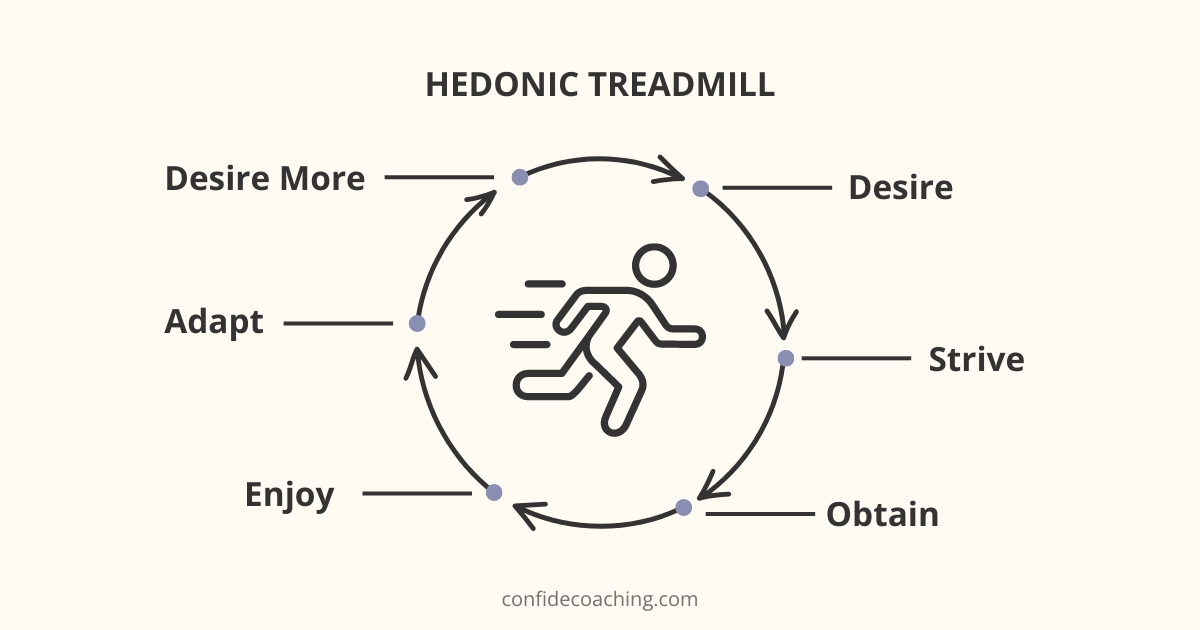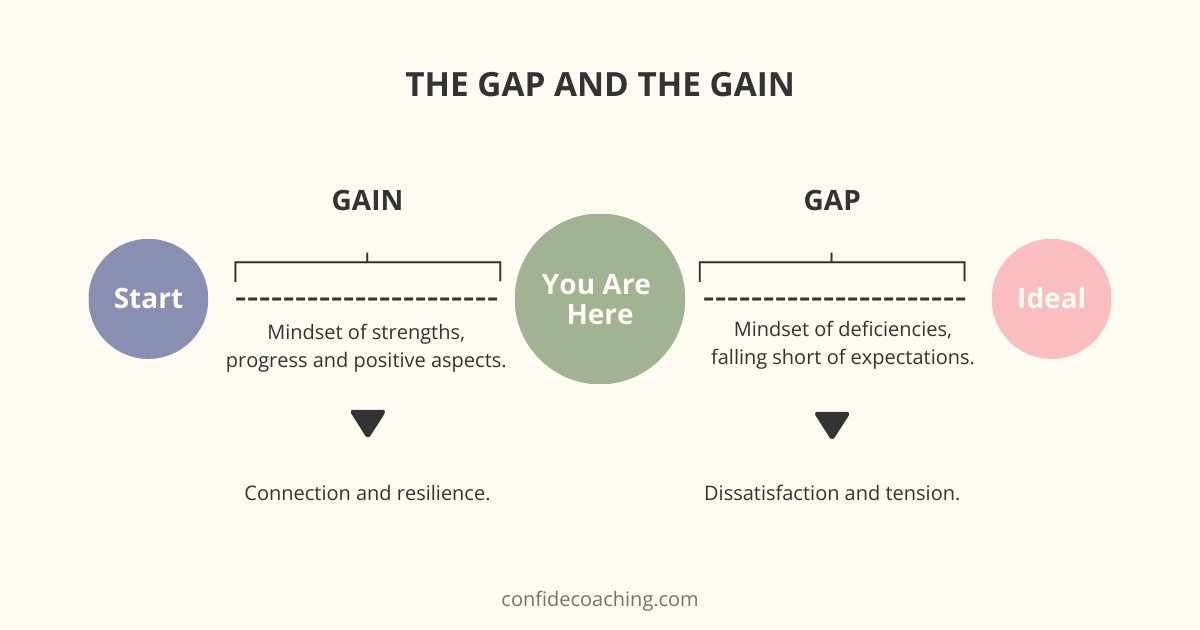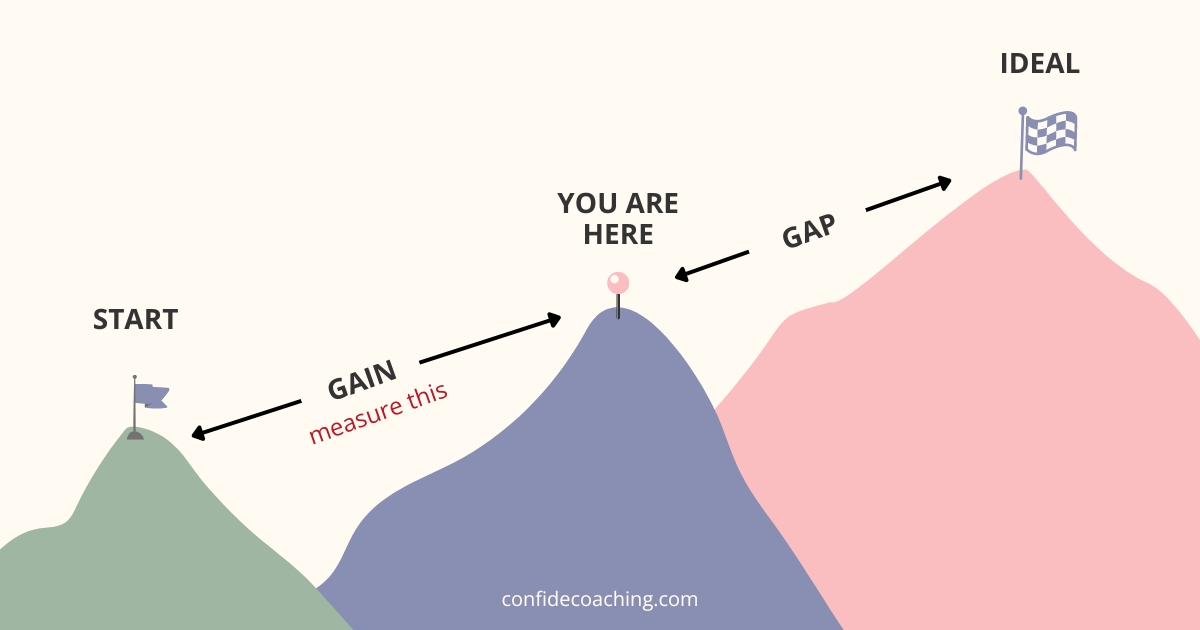
As successful entrepreneurs, business owners, and executives, we often find ourselves trapped in a paradox. Despite our accomplishments and milestones, there’s a nagging feeling of dissatisfaction. It’s as if no matter how much we achieve, the horizon of our goals keeps moving further away, leaving us perpetually unfulfilled.
I’ve encountered this paradox in many of my life coaching clients, which is why “The Gap and The Gain” by Dan Sullivan and Dr. Benjamin Hardy immediately caught my attention. Co-authored by the founder of Strategic Coach, this book offers a transformative mindset shift that addresses this common entrepreneurial plight. By applying the principles of Gap and Gain thinking in my practice and personal life, I’ve witnessed firsthand how effective they can be in turning dissatisfaction into a source of personal and professional growth.
This article highlights the importance of developing a Gain thinking perspective as a powerful tool for achieving happiness and fulfillment. It provides practical exercises to implement these ideas and explores the many benefits they bring to our lives and careers. Here, you will learn how to recognize and escape the Gap, embrace the Gain, and ultimately achieve satisfaction not in the distant future but right now.
The Concept of The Gap
What is Gap Thinking?
The Gap represents the constant chase of an ideal, where one measures themselves against an unattainable future ideal. It’s a state of mind where you focus on what you haven’t achieved rather than what you have. In this mindset, success is always somewhere in the future, just out of reach. Entrepreneurs and high achievers often fall into this trap, setting ever-higher standards and feeling disappointed when they don’t meet these lofty goals. This constant comparison to an ideal that keeps shifting further away is the source of dissatisfaction with ourselves no matter how much we’ve achieved or got done.
Hedonic Treadmill
This relentless pursuit of happiness is closely tied to the concept of the hedonic treadmill, or hedonic adaptation. The theory suggests that people quickly return to a relatively stable level of happiness despite major positive or negative events or life changes. Essentially, we adapt to our new circumstances, and what once brought joy becomes the new normal. This leads to the “I’ll be happy when” scenarios, where happiness is perpetually deferred to the future: “I’ll be happy when I hit a million dollars in revenue,” “I’ll be happy when I expand my business internationally,” or “I’ll be happy when I finally achieve work-life balance.” These scenarios create a cycle where happiness is always just one more achievement away, trapping us in continuous dissatisfaction.

Negative Outcomes of Gap Thinking
Gap thinking leads to several negative outcomes, particularly for entrepreneurs and highly ambitious people. The most significant is a nagging feeling of dissatisfaction despite visible success. For example, an entrepreneur might have built a thriving business from scratch, but instead of celebrating this achievement, they focus on the next big milestone they haven’t yet reached. This creates a void where self-worth and happiness are tied to future successes rather than current accomplishments. The constant pressure and feeling of never being good enough can also lead to burnout, stress, and a diminished sense of well-being.
Innate Wiring
Humans are inherently wired to fall into Gap thinking due to both societal and psychological influences. Society often sets high standards and promotes a culture of continuous improvement and competition. Social media, for instance, amplifies this by showcasing others’ achievements, leading to constant comparison and a sense of inadequacy. Psychologically, our brains are designed to seek out potential threats and problems, which historically helped us survive but now often leads us to focus on what we lack rather than what we have. This combination of external pressures and internal tendencies makes it easy to slip into Gap thinking.
Understanding these concepts is the first step towards recognizing and breaking free from the Gap. By acknowledging how Gap thinking affects us and why we are predisposed to it, we can begin to shift our focus from what we haven’t achieved to what we have, paving the way for greater happiness and fulfillment.
The Power of Gain Thinking
What is Gain Thinking?
Gain thinking is a transformative mindset that shifts focus from chasing ever-elusive ideals to measuring progress from a starting point. Instead of comparing yourself to an unattainable future goal, you look back at how far you’ve come and celebrate the progress made. This backward measurement emphasizes growth and achievements, fostering a sense of accomplishment and positivity. It’s about recognizing and appreciating the gains you’ve made over time, no matter how small they may seem.

Benefits of Gain Thinking
Embracing Gain thinking can significantly enhance your overall well-being in several ways:
- Increased Happiness: By focusing on your progress rather than what you haven’t achieved, you cultivate a sense of contentment and joy. Celebrating your gains reinforces a positive mindset and allows you to experience happiness in the present moment.
- Enhanced Satisfaction: Recognizing how far you’ve come boosts your satisfaction with life and your accomplishments. This sense of fulfillment provides a stable foundation for continued growth and development.
- Boosted Motivation: Seeing tangible evidence of your progress fuels motivation and inspires you to keep moving forward. Each gain, no matter how small, becomes a stepping stone towards your larger goals, making the journey more enjoyable and less daunting.
- Reduced Stress and Burnout: Gain thinking helps mitigate the constant pressure to achieve more by allowing you to appreciate your current achievements. This reduces stress and the risk of burnout, promoting a healthier, more balanced approach to success.
Strategies for Cultivating Gain Thinking
Successful entrepreneurs, business owners, and executives can intentionally develop Gain thinking to benefit both their professional and personal lives. Here’s how:
- Daily Wins Journal: Keep a daily journal where you record three wins or achievements from your day. These can be small tasks completed, progress on a project, or personal victories. This practice trains your mind to focus on what you’ve accomplished rather than what’s left to do.
- Regular Reflection: Set aside time regularly—weekly, monthly, or quarterly—to reflect on your progress. Look back at where you started and measure the gains you’ve made. This reflection helps you see the bigger picture and appreciate your growth over time.
- Celebrate Milestones: Make it a habit to celebrate milestones, no matter how minor they may seem. Acknowledging and celebrating these achievements reinforces Gain thinking and keeps you motivated.
- Reframe Setbacks: When faced with challenges or setbacks, reframe them as learning opportunities. Focus on what you’ve gained from the experience, such as new knowledge, skills, or resilience, rather than dwelling on the gap between your current situation and your ideal goal.
- Mentorship and Leadership: Apply Gain thinking in your mentorship and leadership roles. Encourage your team to reflect on their progress and celebrate their achievements. This fosters a positive and motivated work environment, enhancing overall productivity and satisfaction.
- Progress Trackers: Use tools like Bullet Journal to record and keep track of your achievements. Visual tracking tools provide a quick overview of your gains and can help you maintain a positive focus.
Implementing Gain thinking through daily wins journals, regular reflection, celebrating milestones, reframing setbacks, and using progress trackers can significantly enhance your well-being and productivity. Studies show that writing down accomplishments increases happiness and reduces depressive symptoms, while regular reflection boosts goal achievement by 42% (Seligman et al., 2005; Matthews, 2007).
Best-selling authors like Ryder Carroll (The Bullet Journal Method), James Clear (Atomic Habits), and B.J. Fogg (Tiny Habits) recommend these practices for their ability to foster motivation, resilience, and continuous growth. It is evident that by focusing on achievements and maintaining a positive outlook, we can cultivate a more fulfilling and balanced approach to both personal and professional success. These are all easy wins we should not overlook.
Implementing Gain Thinking in Everyday Life
Recognize and Reframe Gap Moments
The first step in shifting from Gap thinking to Gain thinking is to recognize when you’re falling into the Gap. This often happens when you focus on what you haven’t achieved or when you compare yourself to others. Here’s how to identify and reframe these moments:
- Identify the Gap: Pay attention to feelings of dissatisfaction or frustration. Ask yourself, “Am I focusing on what I lack or haven’t achieved?”
- Reframe the Situation: Once you recognize Gap thinking, consciously shift your focus. Ask, “What progress have I made?” or “How far have I come from where I started?”
- Use Perspective Shifting: Reinforce Gain thinking by focusing on positive progress. For example, instead of saying, “I’m not there yet,” say, “It’s time to remind myself how much I’ve achieved so far.”
- Practice Mindfulness: Mindfulness techniques can help you stay present and focus on your current achievements rather than future ideals. Techniques such as deep breathing, meditation, or journaling can help maintain this focus.
Daily Reflection on Gains
To solidify the habit of Gain thinking, Dan Sullivan and Dr. Benjamin Hardy recommend incorporating daily reflection on our gains. This exercise involves acknowledging and celebrating daily wins:
- Set Aside Time Daily: Choose a specific time each day, such as before bed or first thing in the morning, to reflect on your day.
- Record Three Wins: Write down three things you accomplished or positive experiences you had during the day. These can be related to work, personal growth, or simple daily tasks.
- Reflect on Each Win: Take a moment to think about each win. Consider why it’s significant and how it contributes to your overall progress.
- Express Gratitude: Express gratitude for each win. This practice not only reinforces Gain thinking but also enhances your overall sense of well-being and contentment.
Measure Progress Backward
Measuring progress backward involves looking at your current position relative to where you started rather than an ideal future. This exercise helps you appreciate your growth and maintain a positive outlook:
- Identify a Starting Point: Choose a specific starting point for a project, goal, or personal journey. This could be the beginning of a business venture, the start of a fitness program, or any other significant milestone.
- Document and Compare Your Progress: Regularly document your progress through journals, spreadsheets, or visual aids like charts. When evaluating, compare your current state to where you began rather than an ideal future. For example, instead of thinking, “I haven’t reached my ultimate goal,” think, “I’ve made significant progress since I began, and although I haven’t reached my goal yet, the key to success is to keep showing up and persevering.”
- Celebrate Achievements: Recognize and celebrate milestones and achievements along the way. Each step forward is a gain, contributing to your overall success and growth. This practice helps prevent falling into Gap thinking.
- Set Realistic Goals: Based on your backward measurements, set realistic, achievable goals. Track consistency, develop new skills, improve personal habits, and enhance relationships as measures of success. This approach ensures continuous progress without reverting to Gap thinking.
- Continuous Improvement: Focus on skill development and small wins for sustained momentum and growth. By continually improving your skills and celebrating small victories, you maintain a steady trajectory of progress. This fosters a growth mindset, ensuring long-term success.

Defining Your Own Success Criteria
To truly implement Gain thinking in everyday life, it’s essential first to clarify how we measure success. Without a clear understanding of our success criteria, it’s easy to fall into the trap of Gap thinking, constantly chasing external validation and unattainable ideals.
When our actions stem from a need-driven mindset, we tell ourselves we need something to feel complete or successful. We believe we need the promotion, need to buy a house in a specific neighborhood, need to be thin, need our income to be above that of our peers, need to maintain a certain status, and need our children to excel academically and athletically in the best schools. This mindset creates a sense of urgency and desperation, as we constantly chase after ideals to prove our worth.
The problem is that these needs are rooted in unresolved internal pain that cannot be resolved externally. As Dan Sullivan and Dr. Benjamin Hardy observe in “The Gap and the Gain,” when driven by need, we avoid looking inside and confronting the truth of our discontent. Instead, we constantly search outwardly to fill the gap within ourselves, essentially using the “wrong tool for the job.”
“I Will Be Successful When…” vs. “I Know I’m Successful When…”
Here is a question for you: Do you think of success as something you are striving for, something you can achieve in the future, or is success something you already have? For most of us, success is viewed as a future goal—something we are constantly working towards but have not yet attained. This future-focused perspective keeps us in a state of pursuit, always keeping our “eyes on the prize.” While this can be motivating, it also means we often overlook the progress we’ve already made and the successes we’ve achieved along the way.
Dean Jackson, a marketing expert and entrepreneur, realized the importance of defining success in present terms while working with Thomas Leonard, the founder of Coach University. He recognized that detaching from aspirational future goals and focusing on the present moment is the only way to experience success. Dean transformed his approach to success by shifting his focus from a distant future to the present moment. He began asking himself how he would know he was being successful right now, rather than in some distant future. This change in perspective marked a transition from thinking “I will be successful when…” to “I know I’m successful when…” (Jackson & Sullivan, 2017).

Living in the now allows us to fully experience and appreciate our successes and progress. It shifts our mindset from what is lacking to what is already abundant in our lives.
Embracing the Present Moment
Dean’s approach highlights a crucial aspect of Gain thinking: the importance of living in the present and recognizing current successes. Here’s why this mindset is transformative:
- Immediate Satisfaction: By defining success in the present, you can find satisfaction and contentment in your daily life, rather than deferring happiness to a future date. This reduces stress and increases overall well-being. As Jon Kabat-Zinn, the founder of Mindfulness-Based Stress Reduction, states, “The best way to capture moments is to pay attention. This is how we cultivate mindfulness. Mindfulness means being awake. It means knowing what you are doing.”
- Alignment with Personal Values: When you shift your focus to what makes you feel successful now, you ensure that your goals align with your true values and desires, rather than societal expectations. This alignment leads to more meaningful and fulfilling achievements.
- Empowerment and Control: This mindset gives you control over your success. You are not dependent on future events or external validation to feel successful. Instead, you acknowledge and celebrate your achievements and progress as they happen. Kabat-Zinn reminds us, “You can’t stop the waves, but you can learn to surf,” emphasizing the importance of navigating life’s challenges by staying present and finding empowerment in the moment.
Developing Your Internal Compass
Defining your own success criteria is essential for achieving self-determination and true fulfillment. When you create personal benchmarks for success, you empower yourself to live a life aligned with your values, rather than conforming to external expectations. This shift allows for a more authentic and satisfying journey toward your goals. Here’s how you can develop a robust internal reference system for measuring your progress and success:
1. Identify Your Reference Points:
- Reflect on what truly matters to you. Consider your core values, passions, and what brings you joy and satisfaction.
- Evaluate different areas of your life, such as personal growth, relationships, health, and work-life balance. Identify what success looks like in each of these domains.
2. Question Your Choices:
- Ask yourself why you have chosen these particular reference points. Are they driven by your genuine desires, or are they influenced by societal pressures and expectations?
- Ensure that your success criteria reflect your authentic values and aspirations, rather than what others deem as successful.
3. Define Success for Yourself:
- Write down what success looks like for you in specific, actionable terms. Be clear and detailed about your personal definition of success.
- For example, “I am successful when I spend quality time with my family every day” or “I am successful when I continuously learn and grow in my field.” These concrete statements help you visualize and strive for meaningful achievements.
4. Avoid Comparisons:
- Limit how often you measure yourself against others. Constantly comparing yourself to others can lead to unnecessary stress and dissatisfaction.
- Focus on your unique journey and progress. Celebrate your achievements, no matter how small, and recognize that everyone’s path to success is different.
5. Self-Determination and Freedom:
- Ensure your success criteria foster a sense of autonomy and freedom. You should feel empowered and in control of your path.
- Set goals that allow you to exercise choice and independence, reinforcing your ability to shape your destiny.
6. Cultivate Resilience and Adaptability:
- Understand that your success criteria may evolve over time as you grow and your circumstances change. Be open to reassessing and adjusting your goals as needed.
- Embrace flexibility and resilience, knowing that the ability to adapt is a critical component of long-term success.
Try It Out: Create Your Success Criteria
Here are practical steps to help you define and measure your personal success criteria:
1. Answer Reflective Questions:
- What are the reference points you measure yourself against?
- Why did you choose those particular reference points?
- How do you define and measure success for yourself?
- How often do you measure yourself against others?
- Are you self-determined and free?
2. Create a List of Success Markers:
- Write down your answers and use them to create a list of personal success markers.
- Ensure this list is flexible and evolving, allowing for changes as your perspective and experiences grow.
3. Regularly Review and Adjust:
- Treat your success criteria as a draft, open to continuous refinement and improvement.
- Regularly review your criteria to ensure they still align with your values and goals.
4. Maintain Internal Reference Points:
- Become your own reference point by measuring your progress internally.
- Focus on your growth and achievements rather than societal expectations.
By developing and following your own success criteria, you gain the autonomy to define what success means to you. This approach ensures that your goals are aligned with your personal values, leading to a more fulfilling and balanced life. The key is to continually refine and improve your criteria as your perspective and experiences change, allowing your internal compass to evolve alongside your life.
Celebrate Progress: The Key to Genuine Satisfaction
As we navigate the demanding paths of entrepreneurship, business ownership, and executive leadership, it’s easy to become trapped in the pursuit of ever-shifting goals. “The Gap and The Gain” by Dan Sullivan and Dr. Benjamin Hardy offers a powerful antidote to this relentless chase. By shifting from Gap thinking—focusing on what we lack—to Gain thinking—celebrating our progress—we can transform our experience of success and satisfaction.
Implementing Gain thinking isn’t just about adopting a new mindset; it’s about fundamentally altering how we perceive and measure our achievements. When we start to value our progress and appreciate the journey, we open ourselves to immediate contentment and long-term fulfillment. This approach not only reduces stress and burnout but also fosters ongoing growth and resilience. By recognizing our gains, we reinforce a positive outlook that propels us forward.
“The Gap and The Gain” teaches us that true success isn’t about reaching a distant, ever-moving horizon. It’s about appreciating where we are right now, valuing the progress we’ve made, and continually striving to improve while staying rooted in the present. By adopting this mindset, we can turn our pursuit of success into a fulfilling journey marked by continuous growth and genuine satisfaction. Let’s move forward with the wisdom to embrace our gains, celebrate our achievements, and live our lives with a renewed sense of purpose and joy.

Paul Strobl, MBA, CPC
Owner of Confide Coaching, LLC
Paul is a Master Life Coach for GenX and GenY executives and business owners. Originally from Houston, Texas, he has been location independent for most of his adult life. He currently resides in the Rhodope Mountains of Bulgaria near the Greek border with his brilliant wife, 14-year-old stepson (officially adopted in 2021!) and a Posavac Hound rescue.
References
Carroll, R. (2018). The Bullet Journal Method: Track the Past, Order the Present, Design the Future. Portfolio.
Clear, J. (2018). Atomic Habits: An Easy & Proven Way to Build Good Habits & Break Bad Ones. Avery.
Fogg, B. J. (2020). Tiny Habits: The Small Changes That Change Everything. Harvest
Hardy, B., & Sullivan, D. (2021). The Gap and The Gain: The High Achievers’ Guide to Happiness, Confidence, and Success. Hay House Inc.
Jackson, D., & Sullivan, D. (Hosts). (2017, June 7). How to Know You’re Being Successful [Audio podcast episode]. In The Joy of Procrastination. Retrieved from https://www.joyofprocrastination.com/podcast/004
Kabat-Zinn, J. (2005). Wherever You Go, There You Are: Mindfulness Meditation in Everyday Life. Hachette Books; 10th edition.
Matthews, G. (2007). The Impact of Commitment, Accountability, and Written Goals on Goal Achievement. Psychology | Faculty Presentations, 3. Retrieved from https://scholar.dominican.edu/psychology-faculty-conference-presentations/3
Seligman, M. E. P., Steen, T. A., Park, N., & Peterson, C. (2005). Positive Psychology Progress: Empirical Validation of Interventions. American Psychologist, 60(5), 410-421.

